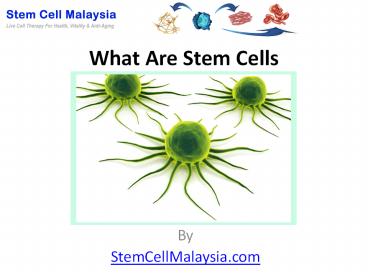Stem Cells - PowerPoint PPT Presentation
Title:
Stem Cells
Description:
Stem cells have actually set off a ton of interest not only in the clinical area yet additionally in individuals from every vocation. The major cause stem cells have stimulated so much attention is because of the belief that stem cell therapy has the potential to remedy numerous diseases. The pleasure has built up to additional chance when not curable conditions are believed to be treatable using stem cells. Many individuals anticipate the chance and appealing capacity of stem cell therapy for terminal diseases such as cancer as well as Acquired Immune Deficiency Syndrome. The excellent headlines of stem cell therapy are just as delighted for people with persistent health problems such as diabetes, Parkinson's condition, movement as well as lots of some other debilitating ailments. – PowerPoint PPT presentation
Number of Views:12234
Title: Stem Cells
1
What Are Stem Cells
- By
- StemCellMalaysia.com
2
Stem Cells Definition
Stem cells can be defined simply as cells which
are not specialized in any specific tissue or
organs. In other words, stem cells have not
differentiated into other cell types to form
tissues and organs.
They are the base or foundational cells to
develop into cells which specialized in certain
functions. Another distinguishing
characteristics of stem cells is their ability to
undergo division, giving rise to more stem cells.
- StemCellMalaysia.com
3
Stem Cells Definition
This is known scientifically as the ability to
self-regenerate. The way stem cells
self-regenerate is to divide and produce two stem
cells with the exact characteristics.
This is what happens initially. As they undergo
further self-regeneration, they soon produce one
stem cell and one cell which has more
differentiation or specialization.
- StemCellMalaysia.com
4
Stem Cells Definition
The significance of stem cells in their
application to the human body and human health
boils down to the two important characteristics
of differentiation and self-regeneration.
Imagine how powerful they can be if stems cells
can be developed into heart cells, especially
when someones heart is doomed to fail.
- StemCellMalaysia.com
5
Stem Cells Definition
Or, for someone with damaged brain cells or nerve
cells, wouldnt it be extremely great news if
stem cells can develop new brain cells or nerve
cells for the person.
Indeed, the potential and possibilities of
exploiting stem cells for medical science and
health science are enormous. Many untreatable
diseases and ailments may in the near future
become curable.
- StemCellMalaysia.com
6
Types of Stem Cells
Stem cells are classified into various types
based on their ability to undergo differentiation
into different cell types.
In other words, their classification, and hence
their name, is derived from their potential to
develop into one, two or several other cell
types.
- StemCellMalaysia.com
7
Types of Stem Cells
For example, oligopotent stem cells can divide
and produce 5 types of blood cells, including
monocytes and macrophages.
Totipotent stem cells have the ability to
differentiate themselves into all cell types.
Pleuripotent stem cell is able to develop into
all cell types, except cells of the embryonic
membranes.
- StemCellMalaysia.com
8
Types of Stem Cells
Scientists have identified the various stem cells
so that targeted research can be performed to
discover specific applications to the human
health and disease treatments.
Understanding the specific types of stem cells
will help applying the right type of stem cells
to the appropriate condition or illness.
- StemCellMalaysia.com
9
Stem Cells In Human Development
The best way to understand stem cells is probably
by looking at ourselves. You and I are formed
from stem cells.
The first stem cell that appears before a fetus
develops is known as zygote. When a sperm cell
penetrates an egg cell from the mother, a zygote
is formed which contains all the genetic
information required to develop a human being.
- StemCellMalaysia.com
10
Stem Cells In Human Development
In a way, the zygote is the superior stem cell,
having the ability to divide and develop into all
cell types.
From the zygote, a whoe pool or mass of
different stem cells are formed, providing the
fetus the necessary stem cells to develop various
parts of the human body.
- StemCellMalaysia.com
11
Stem Cells In Human Development
Once we understand how the master stem cell, the
zygote, enables the development of a human being,
it is not too difficult to imagine the potential
to exploit stem cells for the regeneration of
damaged organs or tissues in an adult.
The question lies in whether we can exploit the
ability of stem cell for whatever treatment
objectives we wish to accomplish.
- StemCellMalaysia.com
12
Stem Cell Malaysia
Thank You. For the rest of the Stem Cells
article please visit
- At
- StemCellMalaysia.com































